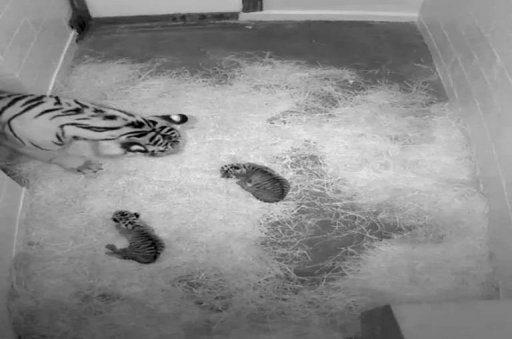Two rare Sumatran tiger cubs born at National Zoo
By Michael E. Ruane, Updated: Thursday, August 8, 5:29 PM
Video: Two rare Sumatran tiger cubs snuggle and nurse with their mother at the Smithsonian’s National Zoo in Washington, D.C.
The keepers knew that their Sumatran tigers had last mated in April. They knew the gestation period for tigers was just over 100 days. And they had been glued to the tiger webcam to see if they could catch the birth live.
On Friday, the Smithsonian National Zoo’s female Sumatran tiger, Damai, started to show signs of discomfort. Her appetite declined. On Sunday, she refused all food.
(Smithsonian's National Zoo) - The Zoo’s female Sumatran tiger, Damai, gave birth to two cubs Monday, August 5.
On Monday evening, keeper Kristen Clark Beatty summoned curator Craig Saffoe to the video feed in her office, saying, “You need to be watching the camera. There’s something really happening.”
There was. At 6:08 p.m., as the keepers watched, Damai delivered her first cub, followed at 8:24 by a second.
“It was a pretty powerful scene to watch,” Saffoe said. Sumatran tigers are listed as critically endangered: Only 400 to 500 exist in the wild. And there are only 65 in accredited zoos in North America.
“How many people on the planet have seen this kind of thing happen before?” Saffoe said. “You count yourself lucky to be a part of it.”
Saffoe spoke after the zoo announced the births Thursday.
The cubs were described as weighing about two pounds, and their eyes were not yet opened. Saffoe said the births followed a very calculated, months-long keepers’ vigil, which involved color-coded calendars. “We really did kind of geek out,” he said. “We had plotted out roughly when she should give birth.”
He described a tense scene as the tiger delivered her cubs. Damai accidentally flung the first cub against the wall, where it hit with an audible smack.
“The keeper and I were sitting there watching, and we both kind of looked at each other as if to say, ‘That can’t be good,’ ” Saffoe said.
For a few moments, as the mother groomed the cub, the keepers couldn’t tell if it was alive.
“We’re just sitting there holding our breath,” he said. They thought they saw the cub’s tail move, then its head. “We knew at that point, ‘Okay, it's alive.’ ”
It was a huge relief, he said. “One of the things that makes us so anxious . . . is that we can’t do anything to help,” he said. “It’s way too dangerous to get in there and try to help. . . . We just have to watch.”
As the keepers watched, Saffoe said, the mother groomed “the bejesus out of the cub.” But Damai also seemed restless and distracted. “It suddenly dawned on at least Kristen and me . . . that she may still be in labor,” he said.
The second cub arrived shortly afterward. The mother then “sacked out,” Saffoe said.
This is the first litter for Damai, 4. The cubs were sired by the zoo’s male Sumatran tiger, 12-year-old Kavi. The cubs will not go outside for about 16 weeks. They must undergo a series of health exams and get vaccinations. But tiger fans can see the cubs on the zoo’s live webcams, and Kavi will be on public exhibit as usual.
The zoo said the cubs, who have not been named, seemed healthy. Their sexes will not be known for four to six weeks, when they’ll get their first physical exam, Saffoe said.
The cubs will examined when the keepers are able to lure the mother outside or into a separate enclosure. The cubs will then be given a quick exam in a corridor outside the den.
Damai came to the zoo in 2011, and Kavi arrived a year ago.
They mated several times in the past nine months. The zoo confirmed that Damai was pregnant on June 21.
“There’s nothing like having cubs,” Saffoe said. “Besides it being cute, it’s a huge conservation plus for us. You feel like you’re on top of the world.”
The Sumatran tiger is relatively small, weighing up to 300 pounds. Male Indian tigers weigh almost twice as much.
Last month, a group of Sumatran tigers reportedly killed one man and treed five others in Indonesia after the men accidentally killed a tiger cub in a jungle deer trap. The men were eventually rescued by police and soldiers after several days in the trees.
Tigers can live up to age 20 in zoos, but most live only about 15 years in the wild.
On Nov. 16, the zoo had to euthanize its elderly Sumatran tiger, Soyono, who was suffering from arthritis and a severe spinal malady. She was 19.
“That was sad to see her go,” Saffoe said. “But, oh my gosh, you can’t follow up the circle of life, of having the sad event losing a good friend, better than having new friends born.”



No comments:
Post a Comment